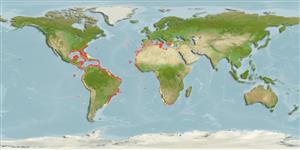Common names from other countries
Environment: milieu / climate zone / depth range / distribution range
экология
пелагический; пределы глубины 0 - 250 m (Ref. 96968). Tropical; 40°N - 36°S, 97°W - 36°E (Ref. 96968)
Pacific Ocean, Atlantic Ocean and the Mediterranean Sea. Subtropical.
Length at first maturity / Size / Вес / Возраст
Maturity: Lm ? range ? - ? cm Max length : 100.0 cm TL самец/пол неопределен; (Ref. 96968)
Female mantle length is 25 cm. Male mantle length is to at least 1.5 cm (Ref. 96968) and maximum mantle length for females is 50 cm (Ref. 105659). Juveniles have been collected at depths ranging from 0 to 250 m (Ref. 96968). Observed at the surface at night but may undergo small diel vertical migrations. Females are reported to feed on pteropod molluscs and small fishes. Known to occur, on occasion, in plague proportions (Ref. 96968).
Life cycle and mating behavior
половая зрелость | размножение | нерест | икра | Fecundity | личинки
Members of the class Cephalopoda are gonochoric. Male and female adults usually die shortly after spawning and brooding, respectively. Mating behavior: Males perform various displays to attract potential females for copulation. During copulation, male grasp the female and inserts the hectocotylus into the female's mantle cavity where fertilization usually occurs. Life cycle: Embryos hatch into planktonic stage and live for some time before they grow larger and take up a benthic existence as adults.
Основная ссылка
ссылки | координатор | соавторы
Turgeon, D.D., J.F. Quinn Jr., A.E. Bogan, E.V. Coan, F.G. Hochberg, W.G. Lyons, P.M. Mikkelsen, R.J. Neves, C.F.E. Roper, G. Rosenberg, B. Roth, A. Scheltema, F.G. Thompson, M. Vecchione and J.D. Willams. 1998. (Ref. 1667)
Статус Красного Списка МСОП (Ref. 130435)
Статус СИТЕС (Ref. 108899)
Not Evaluated
Not Evaluated
Использование человеком
| FishSource |
инструменты
дополнительная информация
ресурсы в Интернет
Estimates based on models
Preferred temperature
(Ref.
115969): 14.7 - 27.1, mean 21 (based on 544 cells).
Категория цены
Unknown.
